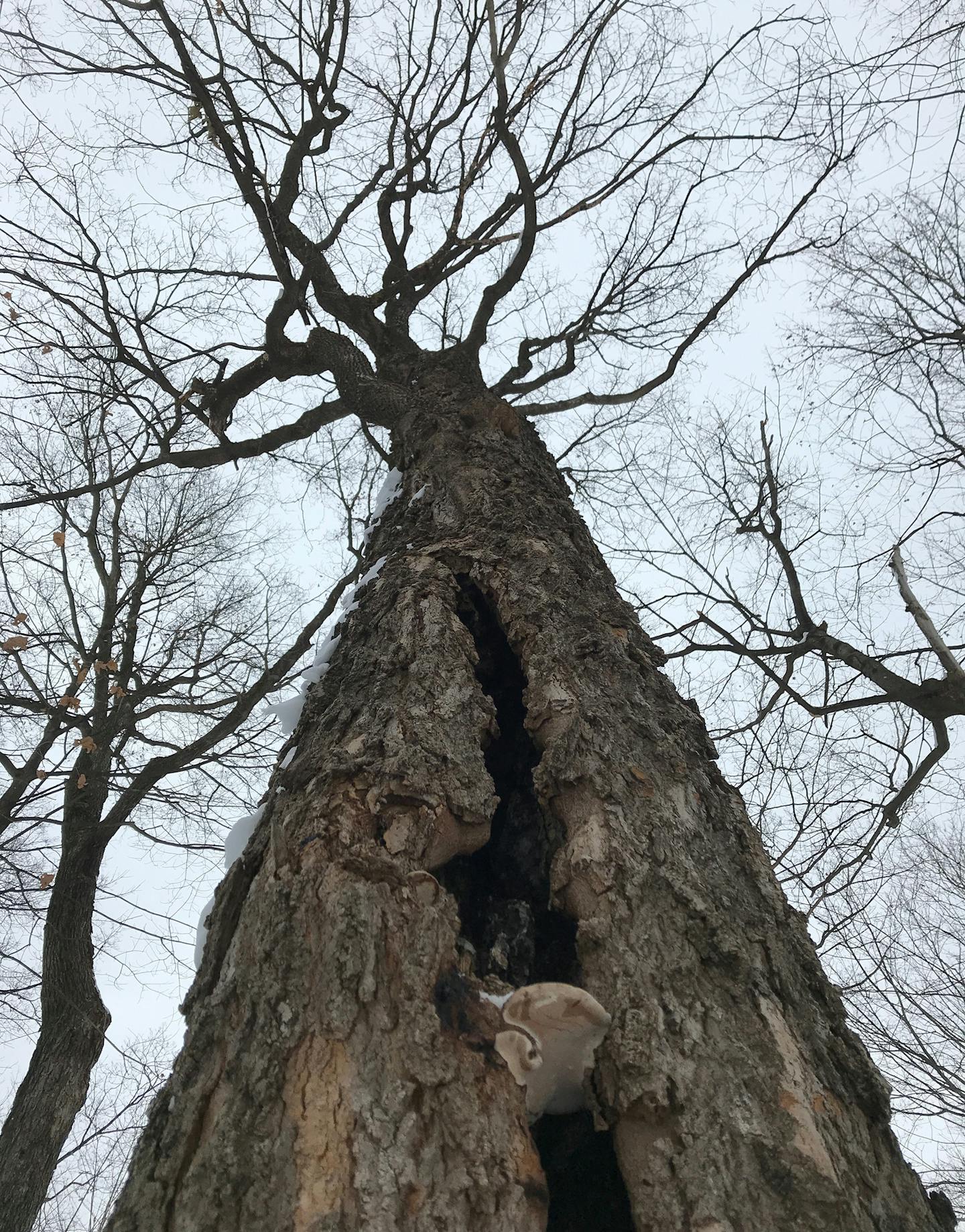"I took a walk in the woods and came out taller than the trees," wrote 19th-century naturalist Henry David Thoreau. I know just what he meant. That sense of contentment and heightened awareness comes with every walk in my favorite woodland.
French fur trappers, traveling west of the Mississippi River more than 300 years ago, found vast grasslands in east-central Minnesota. But on rolling hillsides where standing water limited the spread of prairie fires, grasses gave way to deep woodlands of maple, basswood and oak. They called it bois grande, and the name has endured: Big Woods.
The Big Woods once covered more than 2 million acres in Minnesota. Today this distinctive forest community exists only in scattered fragments. Among the best and largest of these is Wolsfeld Woods Scientific and Natural Area (SNA), located just 15 miles west of downtown Minneapolis.
In summer, the massive trees at Wolsfeld Woods form a leafy canopy so dense that the ground is cast in almost permanent shadow. Wherever a tree has fallen, saplings and shrubs bolt toward the light. Autumn is golden in the Big Woods, the color gradually drifting from above to decorate the forest floor.
Winter offers a completely different experience of Wolsfeld Woods. The sun angles low over the horizon, peeking between lanky tree stems and outstretched, leaf-bare branches. Below, the snow is marked with evidence of activity despite the cold — here a tidy line of arrow-shaped turkey tracks, there a tunnel made by a foraging shrew. People also leave signs of their time in the snowy woods: large, oblong snowshoe prints, narrow lines cut by cross-country skis, and simple bootprints along the trail.
I recently asked Liz Weir, a longtime member of the nonprofit group Friends of Wolsfeld Woods, if she gravitates toward any particular part of the 220-acre site. "I think my favorite spot is on the north side," said Weir. "The trees were cleared of buckthorn and there's just a sense of peace and well-being in the healthy woodland."
The woods seem to change from one visit to the next. I bring binoculars for birding in all seasons, and a camera to capture scenes I want to share. Mostly, I just walk and appreciate the quiet solitude. On one recent ramble, I stopped to admire leaves frozen in a shallow stream. Tiny, wingless snow flies clambered over the snow-crusted ground, and a pileated woodpecker swooped in to hammer at the gnarly bark of an old tree snag. Along the southern loop trail, I came upon several of the state's largest sugar maples. Below them, a stubble of 6-inch seedlings peeked above the snow — the future of the forest.
One mature tree can produce millions of leaves in its lifetime; a woodland of trees makes too many leaves to imagine. Squirrels and chipmunks gather them to line their winter nests, while other animals burrow under the leaf litter to wait out the cold. Meanwhile, microbes, fungi and insects begin the work of decomposition. As the snow melts, ephemeral wildflowers pop up in the enriched soil, grabbing their share of sunlight before the big trees leaf out again.
Preserving the past
In the mid-1850s, while Thoreau wandered and pondered in the woods around Concord, Mass., a family of German immigrants traveled west to settle in Minnesota. The Wolsfelds made their permanent home in the Big Woods northwest of Lake Minnetonka.
Across the state, settlers were converting the prairie and woodlands to farmland. But the Wolsfeld parcel was a challenge, with hilly, glacier-carved terrain and dense woodland that defied plows and wagons. The brothers patched together a living by farming on the lowlands and harvesting wood for local industries. And every spring, they tapped the maples.
"Maple syrup likely saved the large trees at Wolsfeld Woods," said Kelly Randall of the Minnesota Department of Natural Resources. "The family's syruping business supplemented the farm income through the 1940s." Weir said the site also became a popular destination for hikers and families, who stopped to picnic along the lakeshore.
By 1978, Minnesota's expansive Big Woods were barely a memory. "Because of this rarity, and the outstanding quality of the forest, Wolsfeld Woods became one of Minnesota's first scientific and natural areas," Randall said. "SNAs are public lands open to recreation that doesn't disturb natural conditions, such as bird-watching, nature photography, and hiking."
This delicate system still needs protection. Weir worries about erosion on the slopes and trails, which has become more problematic with climate change-fueled heavy rains. Volunteers help to maintain the trails — but they must also manage buckthorn, a highly invasive shrub that crowds out native plants.
Come prepared
Visitors can do their part by respecting the designated uses for Wolsfeld Woods and all of Minnesota's 168 scientific and natural areas. Each SNA offers a unique experience but may not provide conveniences commonly available in parks.
"For example, most of these sites don't have restrooms or drinking water," Randall said. "Visitors need to come prepared." Check the DNR's website for more information.
The Friends of Wolsfeld Woods promotes naturalist programs, events, and other ways for people to enjoy the site. Winter activities include horse-drawn sleigh rides through the snowy woods and maple syrup-making.
"We really hope to teach people about the woods and what a treasure it is, with all its interactions," Weir said. "This is a special place."
Christine Petersen is an environmental educator and freelance writer (christinepetersen.com). She lives in the Twin Cities.







